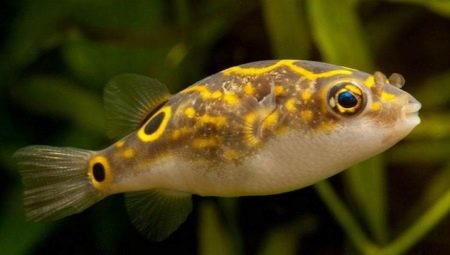Wanting to populate the aquarium with exotic fish, it makes sense to pay attention to dwarf tetradons. They have a very unusual appearance and are even able to change their shade.
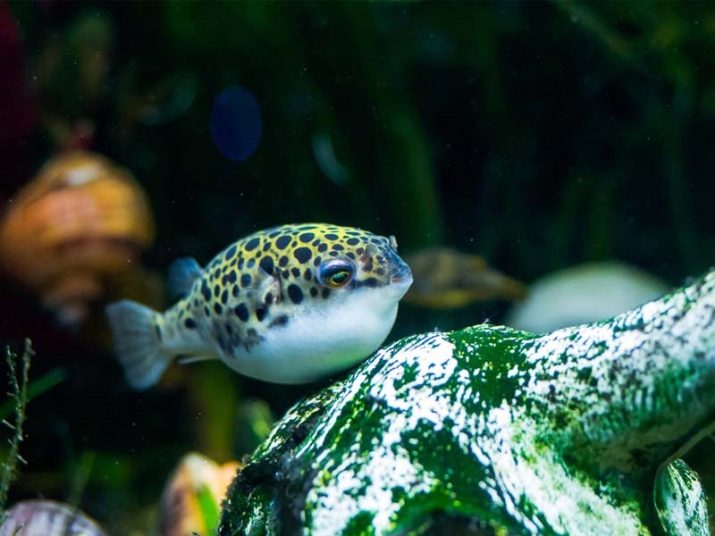
Description
Dwarf tetradon is an aquarium fish native to India, a representative of the family of pufferfish. Its other names are yellow tetradon or dwarf puffer. The predator is not distinguished by outstanding parameters and reaches a length of only 3 centimeters. However, due to the exotic and vibrant appearance, tetradons are quite popular among aquarium holders.
The shape of the fish is a bit like a drop or a pear with a big head. On the surface of the body there are sharp spikes that come to the aid in case of danger. In a calm state, they are not visible, but in case of danger, the dwarf puffer swells and releases thorns. The large eyes of the dwarf tetradon can rotate in different directions independently of each other, which makes it possible to survey the surrounding space without making unnecessary movements.
His abdomen is white or slightly yellowish. The color of the scales varies from green to spotty brown, depending on the condition of the animal. In the mouth, a bit like a bird's beak, there are two tooth plates on top and bottom.
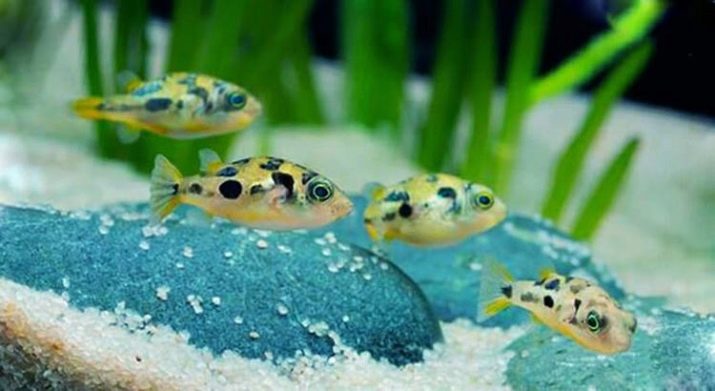
Yellow tetradon is a very smart fish. She notes the appearance of the owner in the room and consciously monitors what is happening.As mentioned above, in stressful situations, the fish transforms, but these transformations, being frequent, negatively affect its health. Therefore, it is strongly not recommended to scare the tetradon specifically.
The fish is quite aggressive and prefers to stay in a pack. She does not use plants. Dwarf tetradons live up to 5 years, subject to quality care.
Dwarf tetradon has a fairly stable immunity, so it gets sick only in case of improper diet, poor water or a dirty aquarium.
If you do not regularly clean the latter, then excess ammonia can be found in the water, a high concentration of which is extremely dangerous for fish. When poisoning the gills of living things become inflamed and redden. In this case, the tank should be cleaned immediately and the concentration of hazardous substances in the water should be checked.

The amount of nitrates also harms the state of tetradone. His behavior immediately changes - the fish feels restless and anxious. Its fins and gills protrude, in addition, breathing problems occur. A sick pet must be transplanted into a separate container filled with clean water of the correct composition. The main aquarium is cleaned at this time.
Dropsy tetradone occurs in case of malnutrition. The disease is easy to identify by a swollen abdomen and a faded color.
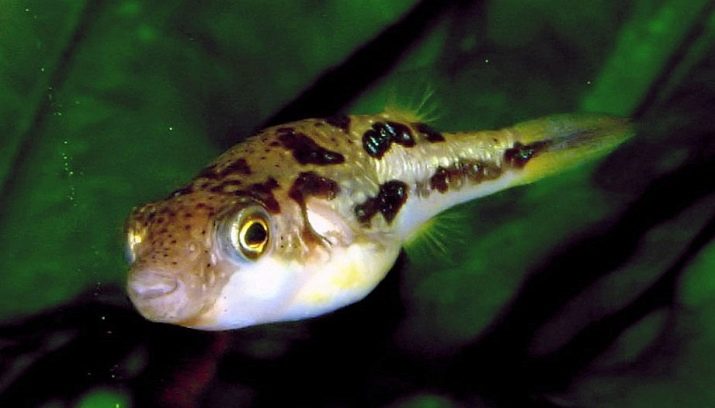
The cost of a tetradon differs depending on its size. The minimum price can be 80 rubles, and the maximum can reach 300 rubles.
Kinds
Dwarf tetradons are divided into several subspecies. Among them red-eyed tetradon, the length of which ranges from 3 to 7 centimeters. The color of the fish also varies depending on the environment and the condition of the creature. Males are chestnut-colored, but females have a softer color - from bronze to sand. You can identify the red-eyed tetradon by the blood-red shade of the iris.
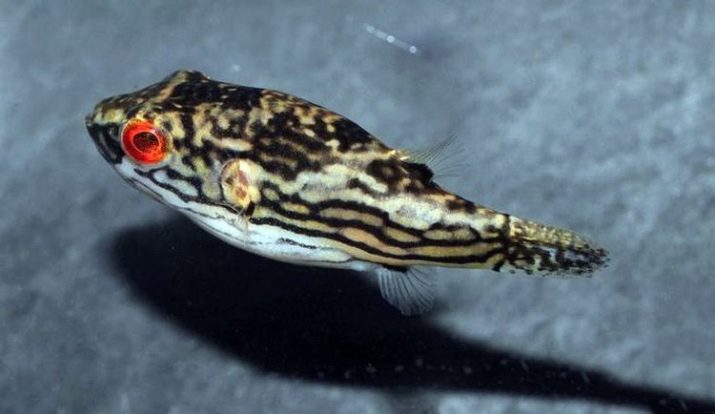
The length of the body of the yellow tetradon does not exceed 2.5 centimeters. Males are characterized by the presence of a brown strip on the abdomen. As you might guess, the color of this species is yellow and very saturated.
Eight Tetradon in length can reach about 10 centimeters. The abdomen of the fish is white, and the back with barrels is painted in a golden hue with dark spots. The back is covered with circles defining the name of this subspecies.
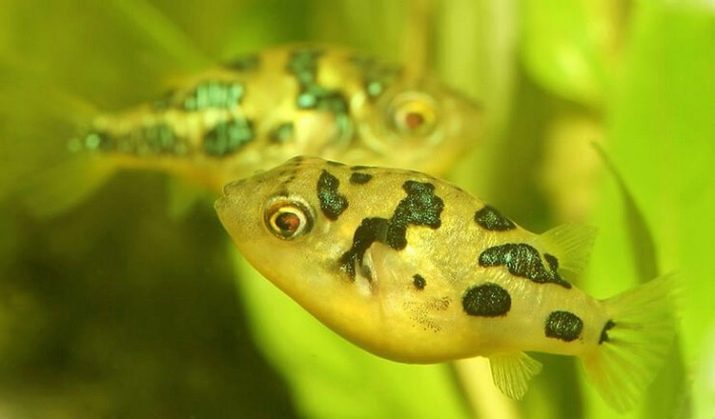
Content Rules
Caring for a dwarf tetradon is not considered too complicated, but this variety is still recommended for people with at least a little experience. Main condition - feed the pet well and keep the water clean and warm. Water temperature should vary from 24 to 26 degrees Celsius.
It is important to ensure that sharp temperature changes do not occur or the hydrochemical composition of the liquid does not change. From time to time, tests should be performed to determine the level of acidity, hardness and amount of ammonia.
The level of acidity should range from 6 to 7.5. The movement of water in the aquarium should be weak. Once a week, about 20% of the fluid is replaced.
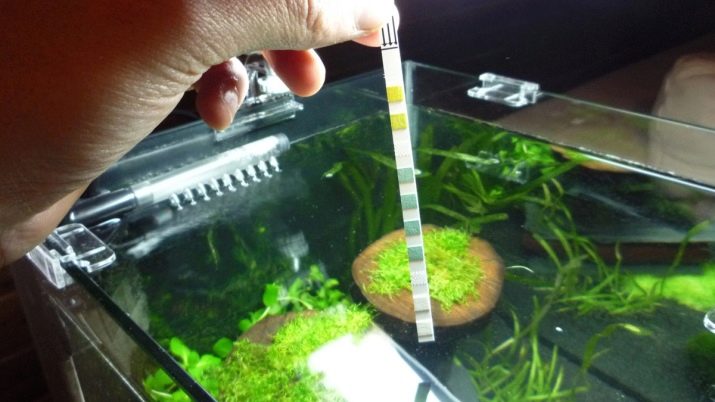
Aquarium selection and equipment
Experts believe that dwarf tetradons do not need volumetric aquariums. In principle, 10 liters will be enough for one fish. Moreover, a small flock is enough for a twenty-liter capacity. The device must be filled with balanced water, as the dwarf puffer does not respond well to the high content of nitrates and ammonia in the water.
Salt should not be added to water, since it is believed that it is it that reduces the life of the fish. It is very important to install a powerful filter, as fish leave a large amount of waste. In addition, regular water replacement is important, helping to reduce the amount of nitrates and ammonia.
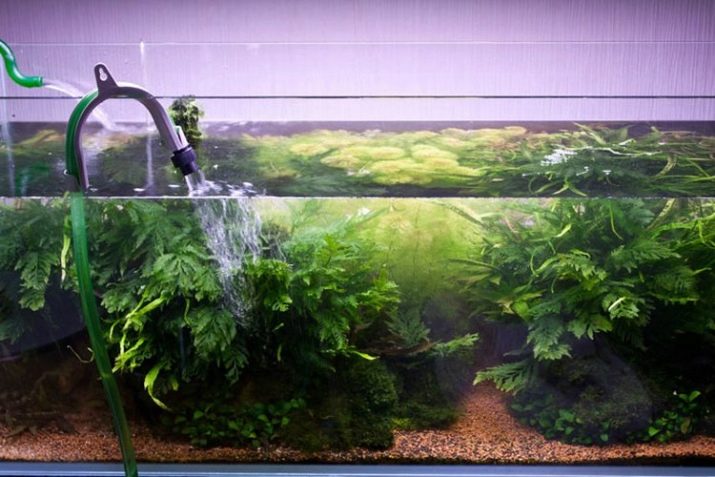
The vessel is better to choose square or rectangular. Round and convex walls cause stress in the inhabitants of the aquarium.Inside the tank, “living” shelters from plants, which include fern, duckweed, lemongrass and others, will be required. Some green inhabitants will need fertilizer. They also all need adequate lighting.
Small pebbles should be poured to the bottom, as well as oak or almond leaves to place a natural tea shade of the soil. You will have to clean the soil at least once a week with a siphon.
In the aquarium you will need to place a set of standard devices. In this case, we are talking about a filter, a compressor and a heater. The filter can be either internal or external, but it is necessary without strong pressure. A heater is only required if the water temperature is too low.
In summer, it is convenient to cool the aquarium using a cooler or a bottle filled with ice. Lighting in the tank can be bright, but only if there is a sufficient number of shady shelters.
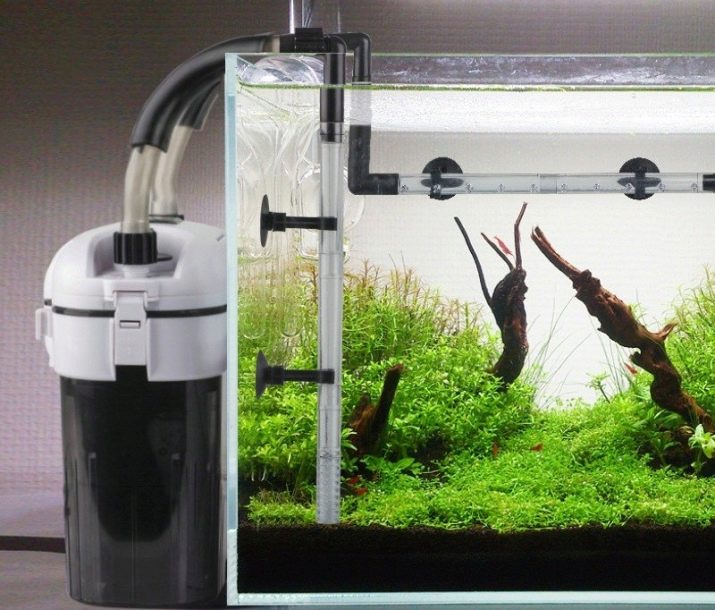
To create natural scenery in the aquarium, snags, stones or grottoes made of natural materials are suitable. In addition, the use of clay pots, coconut shells, ceramic tubes and even artificial plants is encouraged for decoration. Their number should be moderate so that the fish have enough space for movement.
It is better not to use metal decor, since this material changes the composition of water, which adversely affects the state of living creatures. The same applies to artificially painted parts. Before installing the decor, it must be thoroughly rinsed, and driftwood with stones in addition, and boil.
It is important to ensure that objects entering the aquarium do not have sharp corners, as well as unsuccessful sections that can injure the inhabitants.
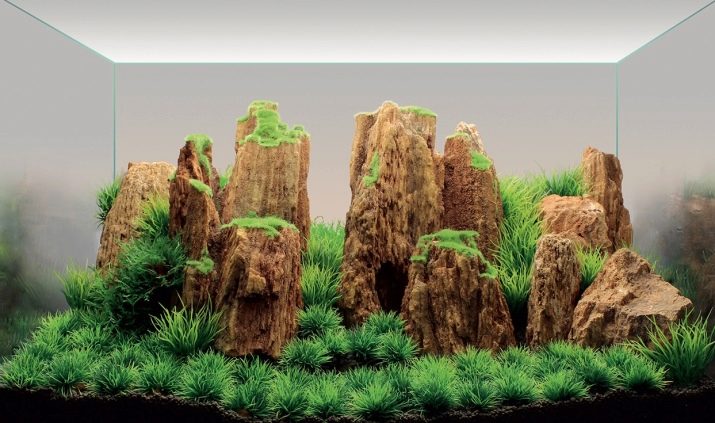
What to feed?
In nature, the dwarf tetradon feeds on snails, insects and small invertebrates. Therefore, at home, you should adhere to a similar regime and abandon artificially created granules and flakes. To ensure proper nutrition, small snails and frozen foods containing bloodworms, brine shrimp or daphnia will be required.
In the case when the fish refuses frozen foods, they should be mixed with live snails, which form the basis of the diet in nature. Previously, the "dish" will need to be disinfected with a solution of potassium permanganate, piperazine or methylene blue.
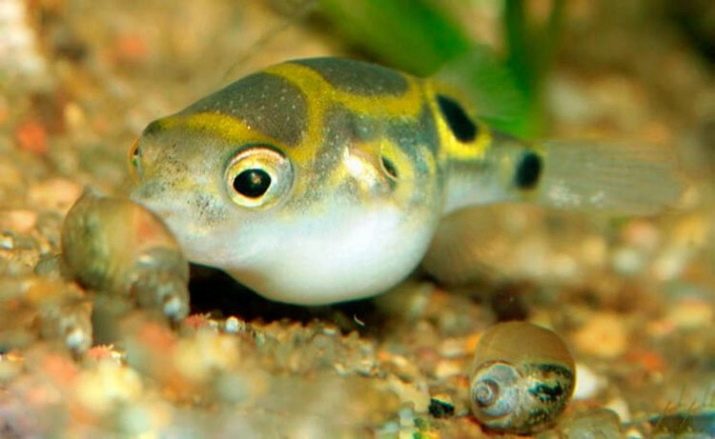
The dwarf puffer prefers small snails, since it is too large to bite with its teeth. Thanks to their shell, fast-growing teeth grind in the pufferfish, which is a significant plus. In order to ensure a regular supply of shellfish, it is better to breed them yourself in a separate container. It is necessary to feed pets once or twice a day.
It is worth mentioning that sometimes owners of aquariums place their pets along with shrimp. This is a rather gross mistake, because invertebrates are just what tetradons eat in nature, which means that all small specimens will be eaten pretty soon. It is better to enrich the diet with squids, earthworms and gammarus intended for fish.
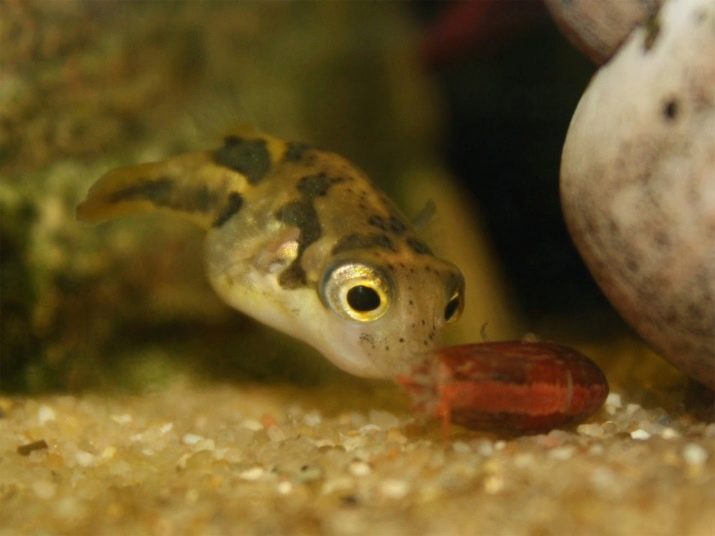
Breeding
Tetradon breeding can take place right in the aquarium, but it will require the organization of a special spawning tank with a filter that does not create a strong flow of water and does not suck fry. There, pre-planted plants.
To distinguish males from females, you will need to carefully study their appearance. The color is richer in male representatives of the species and most often a dark line is visible on their abdomen. Their fins, sometimes, turn yellow. Female fish look thicker and much larger in size.
About two weeks before the start of spawning, it is necessary to begin to fatten tetradones with nutritious live food. Reproduction will require several females and one male.Fish eggs will be thrown on leaves of plants and on the ground. One female, as a rule, gives a dozen eggs.
As soon as the fish lay eggs, they must be relocated to another container. After 5 days, fry should appear. They need to be fed with ciliates, small snails and frozen food.

Compatible with other fish
Surprisingly, tetradons from different owners manifest themselves in different ways. In some cases, they live without problems with other fish, and in others they kill their neighbors and cut off their fins. Ideally, dwarf fish are best kept in a separate aquarium in a group of 5-6 individuals. In this case, the level of aggressiveness will be less, each creature will have its own territory, and tetradons can easily be paired.
If you populate the fish with other species, it is better to choose non-aggressive creatures that feed on plants. For example, we are talking about rainbows, corridors and parsing. In no case should you choose large fish or those that have long fins.

The following video will tell about how to keep and breed dwarf tetradons.
